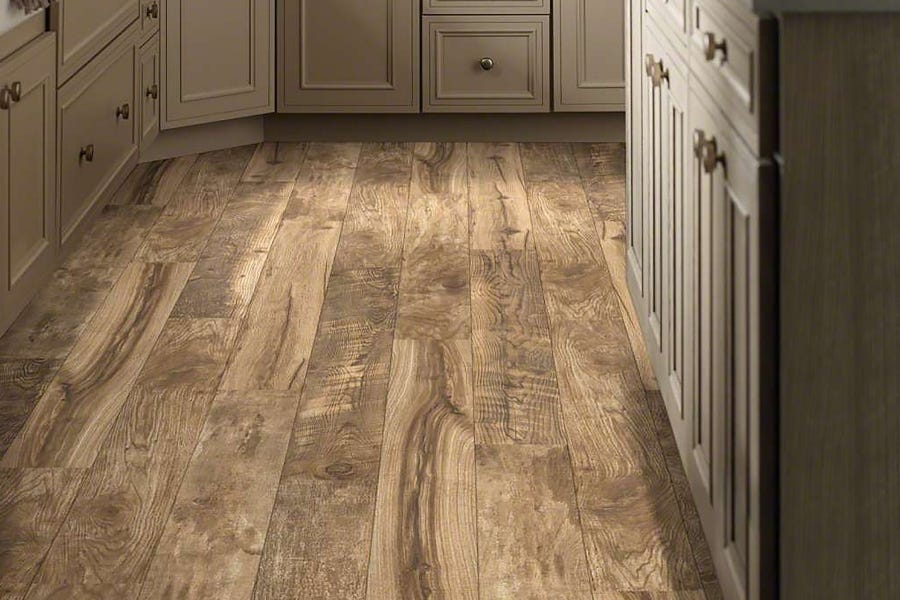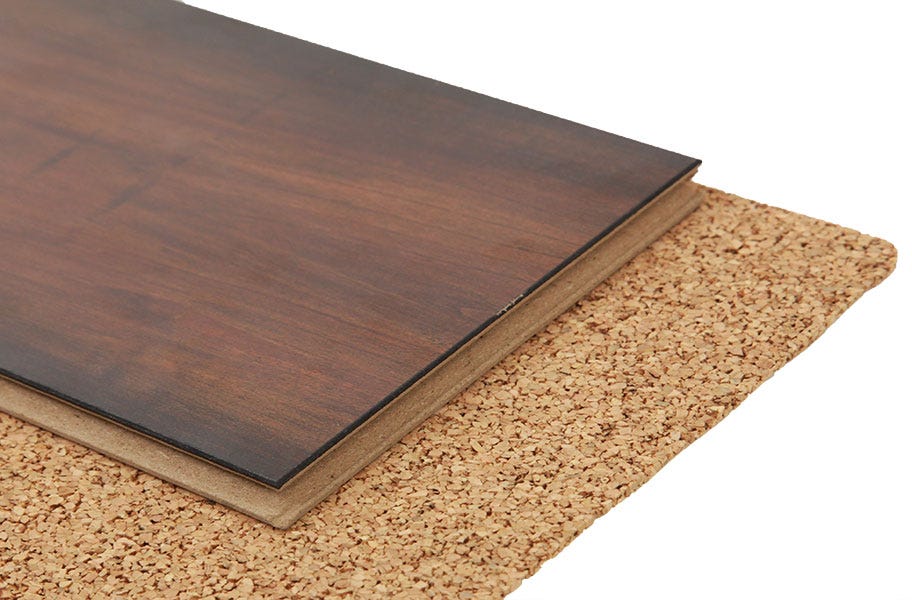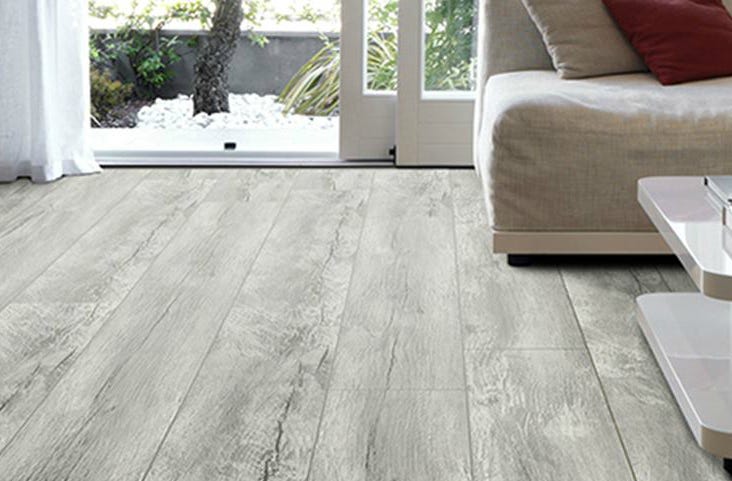
Learn how to install laminate flooring yourself with these easy DIY steps. Tools, tips and tricks - this guide has everything you need for a DIY laminate flooring installation.
Do you like putting puzzles together?
Well, installing laminate flooring is sort of like piecing together a puzzle. But easier.
That’s right, laminate flooring installation is totally a DIY project! You don’t have to worry about glue, grout, adhesives or anything that creates an extra mess. Laminate is installed as a “floating” floor, sitting on top of a subfloor or underlayment much like a finished jigsaw puzzle floats on your coffee table (except you can walk on this one without messing it up).
So clear your Saturday plans, turn on your favorite music and get ready for some DIY home remodeling. Here’s everything you need to learn how to install laminate flooring yourself.
| Related Content >> Laminate Flooring Buying Guide |
Laminate Flooring Installation Tools
The tools you’ll need to install your laminate floor include:
- Tape measurer
- Pen
- Rubber mallet
- Tapping block
- Spacers
- Wide-angle pull bar
- Tile cutter or table saw with a laminate blade
- Jamb saw (for cutting around doorways)
- Underlayment: Most laminate products come with the underlayment attached, but if not you’ll want to purchase one to install under your floor.
- Your laminate floor! (This one’s kind of important.)
SHOP LAMINATE INSTALLATION TOOLS
Tips for Installing Laminate Flooring

Before diving in, we’ve got a few pointers to ensure your DIY laminate flooring installation is successful (and not so stressful):
-
- More flooring, please: If you’re reading this before you’ve bought your flooring, consider buying a wee bit extra product than you think you need to cover your space. It’s recommended to purchase 10% more product than the square footage of your room.
- Allow 24 hours for acclimation: Laminate planks will expand and contract in temperature variations in their environment. We recommend allowing the planks to acclimate to the room for at least 24 hours before installation.
- Use an underlayment: If your laminate floor did not come with an attached underlay, consider using a rubber or cork underlayment on your subfloor below the laminate planks. Underlayment provides more stability for your flooring, minimizes the hollow sound from foot traffic, and helps increase the longevity of your floor.
- Use spacers: If the temperature in your room will change dramatically throughout the year, it may be a good idea to install the flooring using spacers. This will account for necessary expansion and contraction.
- Stagger your planks: Ensure to stagger your seams so that they do not line up in adjacent rows. This will keep your floor from looking funny and unnatural while also compromising the structural stability.
- Mix and match: Avoid placing planks with identical wood grains next to each other.
- Be gentle! When snapping the planks together, be careful not to use too much force to avoid snapping the tongue-and-groove joint.
- Know when to call the professionals: If you’re installing laminate flooring for commercial use in a high-traffic area, glue is recommended to secure the planks. Glue creates a seal between the planks, which also makes it a good choice for moisture-prone areas. However, this type of installation can be trickier as a DIY project, so you may want to hire an installer.
| Related Content >> Cheap Flooring Ideas: Keep Your Budget and Style |
Making Your Laminate Floor More Water-Resistant

While it makes for a scratch-resistant, beautiful wood-look floor, laminate has been known to have one major drawback - it doesn’t do well with moisture.
Thankfully, waterproof laminate flooring is now available. But if you purchased a traditional laminate floor product, or even if you want to increase the water resistance in your waterproof floor, you can take some extra steps in the installation process to make your laminate flooring more water resistant.
- Foam underlayment: If you’re installing laminate flooring in any moisture-prone area like basements, bathrooms or kitchens, a foam underlayment that has an included vapor barrier is your best option.
- Seal the locks: As you install the flooring, apply a laminate flooring sealant to seal up where the planks meet. Sealants don’t glue the planks together, so you can still lift the floor easily if you should need to.
- Caulk the gaps: Caulking areas that are most at risk for water damage - expansion gaps by walls and fixtures - will prevent water from infiltrating your floor. Use silicone caulk around the perimeter to keep water from seeping through.
| Related Content >> Waterproof Laminate Buying Guide |
SHOP WATERPROOF LAMINATE FLOORING
Preparing the Subfloor for Laminate Flooring Installation

You can install laminate over concrete, plywood, parquet, vinyl and many existing floors, but first your subfloor must be solid, flat and clean. Here are some steps to take before laying your laminate flooring:
- If you have a concrete subfloor, fix it first with a patching compound.
- Rip out any carpet or tack-board before installing laminate planks.
- If you have wood subfloors, remove any protruding nails and replace any damaged boards.
- If your laminate floor did not come with an attached underlayment, apply an underlayment over the original flooring before installing the floating laminate floor.
| Related Content >> Understanding Underlayment |
Planning the Room for Laminate Flooring Installation
Various rooms have their weird spots, like doorways and closets, that can make laminate flooring installation a little tricky. Here are a few tips for navigating those areas and installing your laminate floor like a pro:
Doorways
Cutting the trim around doorways is easier than cutting the flooring to match the molding’s shape. The flooring will slip right under the cut trim and it will look polished.
- Lay a laminate floor plank and a section of the underlayment finished-side down next to the door’s molding. Mark on the molding how high up you need to cut.
- You may want to use a jamb saw to make this cut.
The First and Last Rows
Plan the first and last rows of the room:
- Measure the width of the room from the longest wall or focal point in the room. Divide the distance by the width of the planks to determine what the width of the final row of planks should be.
- Allow for a ⅜-inch gap along both walls to allow for any expansion in the planks.
- Calculate the width needed for the first and last row by adding the width of a full plank to the width needed for the last row. Divide this number by two.
- Using a table saw, cut each plank being used in the first and last row to match that width, allowing for the ⅜-inch gaps along both walls.
| Related Content >> Laminate Flooring Myths |
How to Install Laminate Flooring Yourself
Now that you’ve prepared the subfloor and planned out your room, we’re finally getting to the good stuff! Just one more thing before I give you your laminate installation steps.
The underlayment! If your laminate floor did not come with an attached underlayment, lay this out before installing your laminate planks. Roll out your underlayment and trim it to size using a utility knife.
Ensure that any underlayment rolls meet but don’t overlap. You don’t want to feel any bumps in your flooring! Use duct tape to hold the underlayment in place and help maintain the vapor barrier.
Underlayment secure? Great! Now you’re free to install your new floor.
| Related Content >> How to Install Laminate Flooring on Walls |
Laminate Flooring Installation Steps
- Set the first plank in the corner of the room, working from left to right.
- Complete the first row by interlocking the tongue and groove connectors and aligning the seams.
- Continue laying the flooring, using the tapping block and rubber mallet to tap the planks into a locked position.
- When you come up to a wall and need to cut a plank, simply measure the space and mark on the plank where it is you need to cut. We recommend cutting the plank from the surface side with a tile cutter or a table saw to help create a nice finished edge.
- Use the leftover cut ends that are at least 6 inches or longer to begin your next row in order to stagger the planks and give them a more natural wood floor look.
- Set the plank into the previous row at a slight angle to ensure that it slides into place and interlocks correctly.
- Continue moving down the room ensuring that the planks are interlocked and all the seams have a tight fit. Add spacers every few feet around the edges of the flooring and remove them when installation is complete.
Note: You may choose to add a quarter-round molding to cover up the expansion gaps for a more seamless appearance.
| Related Content >> What is a Floating Floor Installation? |
Installing Laminate Flooring FAQs

We don’t expect you to be a laminate flooring installation expert just yet. Here are our answers to a few more questions you may have.
How long does it take to install laminate flooring?
This will vary from person to person, and it depends on how large your room is, how many rooms you’re installing the floor in, and how prepared you are.
A safe suggestion is to not make plans for the whole day, but this is what your installation breakdown might look like:
- Allow at least one full day after unpacking the flooring to give it time to acclimate to the environment before laying it out.
- Laying laminate flooring in a regular-sized bedroom or living room will likely take only two or three hours.
- Add 1-2 hours for those tricky areas, like around cabinets and doorways.
Do I need to buy an underlayment?
If your laminate floor product did not come with an attached underlayment, you will definitely want to install an underlayment before laying your laminate planks. We recommend a foam underlayment with a vapor barrier for more water resistance, or a cork underlayment if you’re worried about sound transmission (such as between apartments or condos).
How much does it cost to install laminate flooring?
The cost to hire a professional varies depending on the region you live in. But the average cost to install laminate flooring is anywhere from $1,600-$5,000...per 200 sq. ft. room! That doesn’t even include removing any old flooring or re-installing molding or baseboards. The real question is, what will you do with all the money you’re saving by doing it yourself?
Show Off Your Finished Floor
Now that you’ve installed your new laminate floor, the final step is to show it off! We want to see your finished project. Upload your photos to Facebook or Instagram with the hashtag #flooringinc and tag us @Flooringinc. You can even win a $50 Visa gift card if your photo is chosen for the Review of the Month contest!



So thanks for sharing a detail information